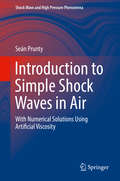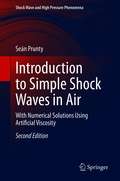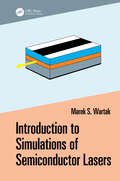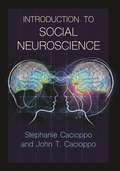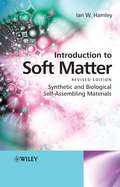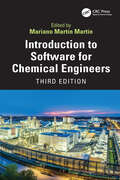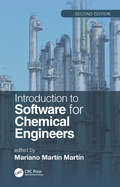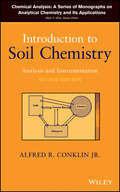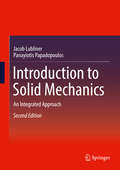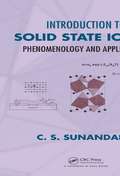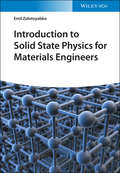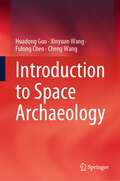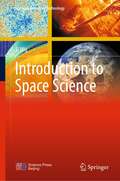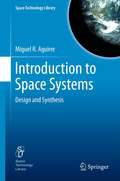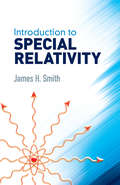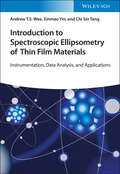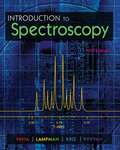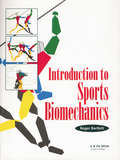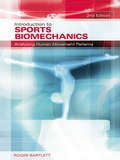- Table View
- List View
Introduction to Shore Wildflowers of California, Oregon, and Washington: Revised Edition (California Natural History Guides #67)
by Philip A. MunzThe diverse coastal habitats of the spectacular Pacific Coast include sandy beaches and dunes, salt- and freshwater marshes, coastal prairies and bluffs, riparian woodlands, and coniferous forests. This guide, first published nearly forty years ago, has introduced thousands to the wildflowers and other plants that grow along the coastline. Now thoroughly updated and revised, it is the perfect field guide to pack for a day at the seashore anywhere in California or the Pacific Northwest. * 268 species are described and illustrated by a new color photograph, a precise line drawing, or both * Includes native and introduced species of wildflowers, common trees, and shrubs * This new edition includes more plants, gives helpful hints for identifying species, and incorporates new taxonomic and distribution information
Introduction to Simple Shock Waves in Air
by Seán PruntyThis book provides an elementary introduction to some one-dimensional fluid flow problems involving shock waves in air. The differential equations of fluid flow are approximated by finite difference equations and these in turn are numerically integrated in a stepwise manner. Artificial viscosity is introduced into the numerical calculations in order to deal with shocks. The presentation is restricted to the finite-difference approach to solve the coupled differential equations of fluid flow as distinct from finite-volume or finite-element methods. This text presents the results arising from the numerical solution using Mathcad programming. Both plane and spherical shock waves are discussed with particular emphasis on very strong explosive shocks in air. This text will appeal to students, researchers, and professionals in shock wave research and related fields. Students in particular will appreciate the benefits of numerical methods in fluid mechanics and the level of presentation.
Introduction to Simple Shock Waves in Air: With Numerical Solutions Using Artificial Viscosity (Shock Wave and High Pressure Phenomena)
by Seán PruntyThis book provides an elementary introduction to one-dimensional fluid flow problems involving shock waves in air. The differential equations of fluid flow are approximated by finite difference equations and these in turn are numerically integrated in a stepwise manner, with artificial viscosity introduced into the numerical calculations in order to deal with shocks. This treatment of the subject is focused on the finite-difference approach to solve the coupled differential equations of fluid flow and presents the results arising from the numerical solution using Mathcad programming. Both plane and spherical shock waves are discussed with particular emphasis on very strong explosive shocks in air. This expanded second edition features substantial new material on sound wave parameters, Riemann's method for numerical integration of the equations of motion, approximate analytical expressions for weak shock waves, short duration piston motion, numerical results for shock wave interactions, and new appendices on the piston withdrawal problem and numerical results for a closed shock tube.This text will appeal to students, researchers, and professionals in shock wave research and related fields. Students in particular will appreciate the benefits of numerical methods in fluid mechanics and the level of presentation.
Introduction to Simulations of Semiconductor Lasers
by Marek WartakSimulations play an increasingly important role not only in scientific research but also in engineering developments. Introduction to Simulations of Semiconductor Lasers introduces senior undergraduates to the design of semiconductor lasers and their simulations. The book begins with explaining the physics and fundamental characteristics behind semiconductor lasers and their applications. It presumes little prior knowledge, such that only a familiarity with the basics of electromagnetism and quantum mechanics is required. The book transitions from textbook explanations, equations, and formulas to ready-to-run numeric codes that enable the visualization of concepts and simulation studies. Multiple chapters are supported by MATLAB code which can be accessed by the students. These are ready-to-run, but they can be modified to simulate other structures if desired. Providing a unified treatment of the fundamental principles and physics of semiconductors and semiconductor lasers, Introduction to Simulations of Semiconductor Lasers is an accessible, practical guide for advanced undergraduate students of Physics, particularly for courses in laser physics.Key Features: A unified treatment of fundamental principles Explanations of the fundamental physics of semiconductor Explanations of the operation of semiconductor lasers An historical overview of the subject
Introduction to Social Neuroscience
by John T. Cacioppo Stephanie CacioppoA textbook that lays down the foundational principles for understanding social neuroscienceHumans, like many other animals, are a highly social species. But how do our biological systems implement social behaviors, and how do these processes shape the brain and biology? Spanning multiple disciplines, Introduction to Social Neuroscience seeks to engage students and scholars alike in exploring the effects of the brain’s perceived connections with others. This wide-ranging textbook provides a quintessential foundation for comprehending the psychological, neural, hormonal, cellular, and genomic mechanisms underlying such varied social processes as loneliness, empathy, theory-of-mind, trust, and cooperation.Stephanie and John Cacioppo posit that our brain is our main social organ. They show how the same objective relationship can be perceived as friendly or threatening depending on the mental states of the individuals involved in that relationship. They present exercises and evidence-based findings readers can put into practice to better understand the neural roots of the social brain and the cognitive and health implications of a dysfunctional social brain. This textbook’s distinctive features include the integration of human and animal studies, clinical cases from medicine, multilevel analyses of topics from genes to societies, and a variety of methodologies.Unveiling new facets to the study of the social brain’s anatomy and function, Introduction to Social Neuroscience widens the scientific lens on human interaction in society.The first textbook on social neuroscience intended for advanced undergraduates and graduate studentsChapters address the psychological, neural, hormonal, cellular, and genomic mechanisms underlying the brain’s perceived connections with othersMaterials integrate human and animal studies, clinical cases, multilevel analyses, and multiple disciplines
Introduction to Soft Matter
by Ian W. HamleyThis book provides an introduction to this exciting and relatively new subject with chapters covering natural and synthetic polymers, colloids, surfactants and liquid crystals highlighting the many and varied applications of these materials. Written by an expert in the field, this book will be an essential reference for people working in both industry and academia and will aid in understanding of this increasingly popular topic. Contains a new chapter on biological soft matterNewly edited and updated chapters including updated coverage of recent aspects of polymer science.Contain problems at the end of each chapter to facilitate understanding
Introduction to Software for Chemical Engineers
by Mariano Martín MartínThe field of chemical engineering and its link to computer science is in constant evolution, and engineers have an ever-growing variety of tools at their disposal to tackle everyday problems. Introduction to Software for Chemical Engineers, Third Edition provides a quick guide to the use of various computer packages for chemical engineering applications. It covers a range of software applications, including Excel and general mathematical packages such as MATLAB®, MathCAD, R, and Python. Coverage also extends to process simulators such as CHEMCAD, HYSYS, and Aspen; equation-based modeling languages such as gPROMS; optimization software such as GAMS, AIMS, and Julia; and specialized software like CFD or DEM codes. The different packages are introduced and applied to solve typical problems in fluid mechanics, heat and mass transfer, mass and energy balances, unit operations, reactor engineering, and process and equipment design and control.This new edition is updated throughout to reflect software updates and new packages. It emphasizes the addition of SimaPro due to the importance of life cycle assessment, as well as general statistics software, SPSS, and Minitab that readers can use to analyze lab data. The book also includes new chapters on flowsheeting drawing, process control, and LOOP Pro, as well as updates to include Pyomo as an optimization platform, reflecting current trends. The text offers a global idea of the capabilities of the software used in the chemical engineering field and provides examples for solving real-world problems.Written by leading experts, this handbook is a must-have reference for chemical engineers looking to grow in their careers through the use of new and improving computer software. Its user-friendly approach to simulation and optimization, as well as its example-based presentation of the software, makes it a perfect teaching tool for both undergraduate- and graduate-level readers.
Introduction to Software for Chemical Engineers, Second Edition
by Mariano Martín MartínThe field of Chemical Engineering and its link to computer science is in constant evolution and new engineers have a variety of tools at their disposal to tackle their everyday problems. Introduction to Software for Chemical Engineers, Second Edition provides a quick guide to the use of various computer packages for chemical engineering applications. It covers a range of software applications from Excel and general mathematical packages such as MATLAB and MathCAD to process simulators, CHEMCAD and ASPEN, equation-based modeling languages, gProms, optimization software such as GAMS and AIMS, and specialized software like CFD or DEM codes. The different packages are introduced and applied to solve typical problems in fluid mechanics, heat and mass transfer, mass and energy balances, unit operations, reactor engineering, process and equipment design and control. This new edition offers a wider view of packages including open source software such as R, Python and Julia. It also includes complete examples in ASPEN Plus, adds ANSYS Fluent to CFD codes, Lingo to the optimization packages, and discusses Engineering Equation Solver. It offers a global idea of the capabilities of the software used in the chemical engineering field and provides examples for solving real-world problems. Written by leading experts, this book is a must-have reference for chemical engineers looking to grow in their careers through the use of new and improving computer software. Its user-friendly approach to simulation and optimization as well as its example-based presentation of the software, makes it a perfect teaching tool for both undergraduate and master levels.
Introduction to Soil Chemistry: Analysis and Instrumentation (Chemical Analysis: A Series of Monographs on Analytical Chemistry and Its Applications #Vol. 167)
by Alfred R. ConklinProvides the tools needed to explore the incredible complexities of the earth's soils Now in its Second Edition, this highly acclaimed text fully equips readers with the skills and knowledge needed to analyze soil and correctly interpret the results. Due to the highly complex nature of soil, the author carefully explains why unusual results are routinely obtained during soil analyses, including the occurrence of methane in soil under oxidative conditions. The text also assists readers in developing their own analytical techniques in order to analyze particular samples or test for particular compounds or properties. The Second Edition of Introduction to Soil Chemistry features four new chapters. Moreover, the entire text has been thoroughly updated and revised. It begins with a review of the history of soil chemistry, introducing fundamental concepts that apply to all soils. Next, the text explores: Basic soil characteristics, horizonation, texture, clay, air, water, solids, organic matter, organisms, and fundamental chemical concepts essential to soil chemistry Tested and proven sampling techniques for soil analysis that provide reliable analytical results Basic soil measurement techniques and extraction procedures Instrumentation to isolate and identify soil chemicals, including plant nutrients and contaminants Detailed examples and figures throughout the text help readers successfully perform soil sampling and analytical methods as well as better understand soil's chemical characteristics. At the end of each chapter, a bibliography and list of references lead to additional resources to explore individual topics in greater depth. Each chapter also offers problem sets, encouraging readers to put their newfound skills into practice. Reflecting the latest research findings and best practices, the Second Edition of Introduction to Soil Chemistry is ideal for both students and soil chemists who want to explore the incredible complexities of the earth's soils.
Introduction to Sol-Gel Processing (International Series In Sol-gel Processing #1)
by Alain C. PierreThis book presents a broad, general introduction to the processing of Sol-Gel technologies. This updated volume serves as a general handbook for researchers and students entering the field. This new edition provides updates in fields that have undergone rapid developments, such as Ceramics, Catalysis, Chromatropgraphy, biomaterials, glass science, and optics. It provides a simple, compact resource that can also be used in graduate-level materials science courses.
Introduction to Solid Mechanics
by Jacob Lubliner Panayiotis PapadopoulosIntroduction to Solid Mechanics: An Integrated Approach presents for the first time in one text the concepts and processes covered in statics and mechanics of materials curricula following a granular, topically integrated approach. Since the turn of the millennium, it has become common in engineering schools to combine the traditional undergraduate offerings in rigid-body statics (usually called "statics") and deformable body mechanics (known traditionally as "strength of materials" or, more recently, "mechanics of materials") into a single, introductory course in solid mechanics. Many textbooks for the new course sequentially meld pieces of existing, discrete books--sometimes, but not always, acknowledging the origin--into two halves covering Statics and Mechanics of Materials. In this volume, Professors Lubliner and Papadopoulos methodically combine the essentials of statics and mechanics of materials, illustrating the relationship of concepts throughout, into one "integrated" text. Introduction to Solid Mechanics: An Integrated Perspective offers a holistic treatment of the depth and breadth of solid mechanics, proceeding from first principles to applications.
Introduction to Solid Mechanics
by Jacob Lubliner Panayiotis PapadopoulosThis expanded second edition presents in one text the concepts and processes covered in statics and mechanics of materials curricula following a systematic, topically integrated approach. Building on the novel pedagogy of fusing concepts covered in traditional undergraduate courses in rigid-body statics and deformable body mechanics, rather than simply grafting them together, this new edition develops further the authors' very original treatment of solid mechanics with additional figures, an elaboration on selected solved problems, and additional text as well as a new subsection on viscoelasticity in response to students' feedback. Introduction to Solid Mechanics: An Integrated Approach, Second Edition, offers a holistic treatment of the depth and breadth of solid mechanics and the inter-relationships of its underlying concepts. Proceeding from first principles to applications, the book stands as a whole greater than the sum of its parts.
Introduction to Solid Mechanics: An Integrated Approach
by Jacob Lubliner Panayiotis PapadopoulosThis expanded second edition presents in one text the concepts and processes covered in statics and mechanics of materials curricula following a systematic, topically integrated approach. Building on the novel pedagogy of fusing concepts covered in traditional undergraduate courses in rigid-body statics and deformable body mechanics, rather than simply grafting them together, this new edition develops further the authors’ very original treatment of solid mechanics with additional figures, an elaboration on selected solved problems, and additional text as well as a new subsection on viscoelasticity in response to students’ feedback. Introduction to Solid Mechanics: An Integrated Approach, Second Edition, offers a holistic treatment of the depth and breadth of solid mechanics and the inter-relationships of its underlying concepts. Proceeding from first principles to applications, the book stands as a whole greater than the sum of its parts.
Introduction to Solid State Ionics: Phenomenology and Applications
by C. S. SunandanaIntroduction to Solid State Ionics: Phenomenology and Applications presents a pedagogical, graduate-level treatment of the science and technology of superionic conductors, also known as fast ion conductors or solid electrolytes. Suitable for physics, materials science, and engineering researchers and students, the text emphasizes basic physics and
Introduction to Solid State Physics for Materials Engineers
by Emil ZolotoyabkoA concise, accessible, and up-to-date introduction to solid state physics Solid state physics is the foundation of many of today’s technologies, including transistors, LEDs, optoelectronics, and communications. Introduction to Solid State Physics for Materials Engineers offers a guide to basic concepts and provides an accessible framework for understanding this highly application-relevant subject for materials engineers. The text links the fundamentals of modern materials, such as graphene and photonic materials, and of applications, such as high-temperature superconductors and MOSFETs. Written by a noted expert and experienced instructor, the book contains numerous worked examples throughout to help the reader gain a thorough understanding of the concepts and information presented. The text covers a wide range of relevant topics, including electron waves in crystals, electrical conductivity in semiconductors, light interaction with metals and dielectrics, light interaction with semiconductors, cooperative phenomena in electron systems, cooperative phenomena in electron systems, ferroelectricity as a cooperative phenomenon, and more. This important book: Provides a big picture view of solid state physics Contains examples of basic concepts and applications Offers a highly accessible text that fosters real understanding Presents a wealth of helpful worked examples Written for students of materials science, engineering, and physics, Introduction to Solid State Physics for Materials Engineers is an important guide to help foster an understanding of solid state physics.
Introduction to Space Archaeology
by Cheng Wang Xinyuan Wang Fulong Chen Huadong GuoThis book presents the basic principles and the latest advances in space archaeology. Following general reviews of the state of the art of Earth observation technologies and archaeology, the book introduces the principles and methods of space archaeology, remote sensing methods for archaeological survey, and integrated archaeological survey methods including geophysics, virtual reality, web technologies, global positioning systems (GPS), geographical information systems (GIS), and big data. The book then presents two chapters on case studies of word heritage sites in Asia, Europe, Africa, and Americas, including three major world heritage sites in China: The Great Wall, Grand Canal, and Silk Road. The last chapter of the book discusses the future of space archaeology. This book has an interdisciplinary appeal and scholars with an interest in cultural heritage and remote sensing technologies for Earth value its contribution.
Introduction to Space Physics
by Margaret G. Kivelson Christopher T. RussellDesigned as a text for upper-level undergraduate and first-year graduate students, this volume attempts to establish the curriculum for the modern student entering the fledgling field of space physics. The book provides a broad, yet selective, treatment of the subject, covering virtually all aspects of space plasmas in the solar system. There are sections on the sun and solar wind, the magnetized and unmagnetized planets, and the fundamental process of space plasmas including shocks, plasma waves, ULF waves, wave-particle interactions, and auroral processes. In addition to emphasizing analysis, the authors also place importance on underlying phenomenology with extensive attention to observations.
Introduction to Space Science (Springer Aerospace Technology)
by Ji WuThis book highlights the technological and managerial fundamentals and frontier questions of space science. Space science is a new interdisciplinary and comprehensive subject that takes spacecraft as the main tools to study the planet Earth, the solar-terrestrial space, the solar system, and even the whole universe, to answer significant questions covering the formation and evolution of the solar system and the universe, the origin and evolution of life and the structure of the material. The book introduces major scientific questions in various branches of space science and provides related technological and managerial knowledge. It also discusses the necessity of international cooperation and elaborates on the strategic planning of space science in China. The book can be used as a reference book or textbook for scientists, engineers, college students, and the public participating in space science programs.
Introduction to Space Systems
by Miguel A. AguirreThe definition of all space systems starts with the establishment of its fundamental parameters: requirements to be fulfilled, overall system and satellite design, analysis and design of the critical elements, developmental approach, cost, and schedule. There are only a few texts covering early design of space systems and none of them has been specifically dedicated to it. Furthermore all existing space engineering books concentrate on analysis. None of them deal with space system synthesis - with the interrelations between all the elements of the space system. Introduction to Space Systems concentrates on understanding the interaction between all the forces, both technical and non-technical, which influence the definition of a space system. This book refers to the entire system: space and ground segments, mission objectives as well as to cost, risk, and mission success probabilities. Introduction to Space Systems is divided into two parts. The first part analyzes the process of space system design in an abstract way. The second part of the book focuses on concrete aspects of the space system design process. It concentrates on interactions between design decisions and uses past design examples to illustrate these interactions. The idea is for the reader to acquire a good insight in what is a good design by analyzing these past designs.
Introduction to Special Relativity (Dover Books on Physics)
by James H. SmithBy the year 1900, most of physics seemed to be encompassed in the two great theories of Newtonian mechanics and Maxwell's theory of electromagnetism. Unfortunately, there were inconsistencies between the two theories that seemed irreconcilable. Although many physicists struggled with the problem, it took the genius of Einstein to see that the inconsistencies were concerned not merely with mechanics and electromagnetism, but with our most elementary ideas of space and time. In the special theory of relativity, Einstein resolved these difficulties and profoundly altered our conception of the physical universe.Readers looking for a concise, well-written explanation of one of the most important theories in modern physics need search no further than this lucid undergraduate-level text. Replete with examples that make it especially suitable for self-study, the book assumes only a knowledge of algebra. Topics include classical relativity and the relativity postulate, time dilation, the twin paradox, momentum and energy, particles of zero mass, electric and magnetic fields and forces, and more.
Introduction to Spectroscopic Ellipsometry of Thin Film Materials: Instrumentation, Data Analysis, and Applications
by Andrew Thye Wee Xinmao Yin Chi Sin TangA one-of-a-kind text offering an introduction to the use of spectroscopic ellipsometry for novel material characterization In Introduction to Spectroscopic Ellipsometry of Thin Film Materials: Instrumentation, Data Analysis and Applications, a team of eminent researchers delivers an incisive exploration of how the traditional experimental technique of spectroscopic ellipsometry is used to characterize the intrinsic properties of novel materials. The book focuses on the scientifically and technologically important two-dimensional transition metal dichalcogenides (2D-TMDs), magnetic oxides like manganite materials, and unconventional superconductors, including copper oxide systems. The distinguished authors discuss the characterization of properties, like electronic structures, interfacial properties, and the consequent quasiparticle dynamics in novel quantum materials. Along with illustrative and specific case studies on how spectroscopic ellipsometry is used to study the optical and quasiparticle properties of novel systems, the book includes: Thorough introductions to the basic principles of spectroscopic ellipsometry and strongly correlated systems, including copper oxides and manganites Comprehensive explorations of two-dimensional transition metal dichalcogenides Practical discussions of single layer graphene systems and nickelate systems In-depth examinations of potential future developments and applications of spectroscopic ellipsometryPerfect for master’s- and PhD-level students in physics and chemistry, Introduction to Spectroscopic Ellipsometry of Thin Film Materials will also earn a place in the libraries of those studying materials science seeking a one-stop reference for the applications of spectroscopic ellipsometry to novel developed materials.
Introduction to Spectroscopy
by Donald L. Pavia; Gary M. Lampman; George S. Kriz; James R. VyvyanThis proven book provides a systematic introduction to spectra and basic theoretical concepts in spectroscopic methods and includes up-to-date spectra; a modern presentation of one-dimensional nuclear magnetic resonance (NMR) spectroscopy; an introduction to biological molecules in mass spectrometry; and coverage of modern techniques alongside DEPT, COSY, and HECTOR.
Introduction to Spintronics
by Supriyo Bandyopadhyay Marc CahayIntroduction to Spintronics provides an accessible, organized, and progressive presentation of the quantum mechanical concept of spin and the technology of using it to store, process, and communicate information. Fully updated and expanded to 18 chapters, featuring many new drill problems, this edition reflects the explosion of study in spin-related physics, addressing seven important physical phenomena with spintronic device applications. It discusses spintronics without magnetism, which allows one to manipulate spin currents by purely electrical means. It explores lateral spin-orbit interaction and its many nuances, as well as the possibility to implement spin polarizers and analyzers using quantum point contacts. It also introduces the concept of single-domain-nanomagnet-based computing.
Introduction to Sports Biomechanics: Analysing Human Movement Patterns
by Roger BartlettFirst published in 1996. Routledge is an imprint of Taylor & Francis, an informa company.
Introduction to Sports Biomechanics: Analysing Human Movement Patterns
by Roger BartlettIntroduction to Sports Biomechanics provides a genuinely accessible and comprehensive guide to all of the biomechanics topics covered in an undergraduate sports and exercise science degree. Now revised and in its second edition, Introduction to Sports Biomechanics is full of visual aids to support the text. Every chapter contains cross references to key terms and definitions from that chapter, learning objectives and summaries, study tasks to confirm and extend your understanding, and suggestions to further your reading. Clearly structured and with many student friendly features, the text covers: movement patterns – exploring the essence and purpose of movement analysis qualitative analysis of sports movements movement patterns and the geometry of motion quantitative measurement and analysis of movement force and torques – causes of movement the human body and the anatomy of movement. This edition is supported by a website containing animation and video clips, and offers sample data tables for comparison and analysis and multiple choice questions to confirm your understanding of the material in each chapter. Introduction to Sports Biomechanics is a must have for students of sport and exercise, human movement sciences, ergonomics, biomechanics, and sports performance and coaching. Visit the companion website at: www.routledge.com/textbooks/9780415339940.

